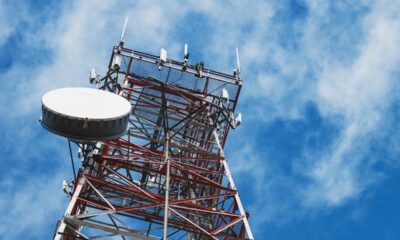Mississippi Today
First hypersonic weapon on a US warship being installed in Pascagoula

The U.S. Navy is transforming a costly flub into a potent weapon with the first shipborne hypersonic weapon, which is being retrofitted aboard the first of its three stealthy destroyers.
The USS Zumwalt is at a Mississippi shipyard where workers have installed missile tubes that replace twin turrets from a gun system that was never activated because it was too expensive. Once the system is complete, the Zumwalt will provide a platform for conducting fast, precision strikes from greater distances, adding to the usefulness of the warship.
“It was a costly blunder. But the Navy could take victory from the jaws of defeat here, and get some utility out of them by making them into a hypersonic platform,” said Bryan Clark, a defense analyst at the Hudson Institute.
The U.S. has had several types of hypersonic weapons in development for the past two decades, but recent tests by both Russia and China have added pressure to the U.S. military to hasten their production.
Hypersonic weapons travel beyond Mach 5, five times the speed of sound, with added maneuverability making them harder to shoot down.
Last year, The Washington Post reported that among the documents leaked by former Massachusetts Air National Guard member Jack Teixeira was a defense department briefing that confirmed China had recently tested an intermediate-range hypersonic weapon called the DF-27. While the Pentagon had previously acknowledged the weapon’s development, it had not recognized its testing.
One of the U.S. programs in development and planned for the Zumwalt is the “Conventional Prompt Strike.” It would launch like a ballistic missile and then release a hypersonic glide vehicle that would travel at speeds seven to eight times faster than the speed of sound before hitting the target. The weapon system is being developed jointly by the Navy and Army. Each of the Zumwalt-class destroyers would be equipped with four missile tubes, each with three of the missiles for a total of 12 hypersonic weapons per ship.
In choosing the Zumwalt, the Navy is attempting to add to the usefulness of a $7.5 billion warship that is considered by critics to be an expensive mistake despite serving as a test platform for multiple innovations.
The Zumwalt was envisioned as providing land-attack capability with an Advanced Gun System with rocket-assisted projectiles to open the way for Marines to charge ashore. But the system featuring 155 mm guns hidden in stealthy turrets was canceled because each of the rocket-assisted projectiles cost between $800,000 and $1 million.
Despite the stain on its reputation, the three Zumwalt-class destroyers remain the Navy’s most advanced surface warship in terms of new technologies. Those innovations include electric propulsion, an angular shape to minimize radar signature, an unconventional wave-piercing hull, automated fire and damage control and a composite deckhouse that hides radar and other sensors.
The Zumwalt arrived at the Huntington Ingalls Industries shipyard in Pascagoula, Mississippi, in August 2023 and was removed from the water for the complex work of integrating the new weapon system. It is due to be undocked this week in preparation for the next round of tests and its return to the fleet, shipyard spokeswoman Kimberly Aguillard said.
A U.S. hypersonic weapon was successfully tested over the summer and development of the missiles is continuing. The Navy wants to begin testing the system aboard the Zumwalt in 2027 or 2028, according to the Navy.
The U.S. weapon system will come at a steep price. It would cost nearly $18 billion to buy 300 of the weapons and maintain them over 20 years, according to the Congressional Budget Office.
Critics say there is too little bang for the buck.
“This particular missile costs more than a dozen tanks. All it gets you is a precise non-nuclear explosion, some place far far away. Is it really worth the money? The answer is most of the time the missile costs much more than any target you can destroy with it,” said Loren Thompson, a longtime military analyst in Washington, D.C.
But they provide the capability for Navy vessels to strike an enemy from a distance of thousands of kilometers — outside the range of most enemy weapons — and there is no effective defense against them, said retired Navy Rear Adm. Ray Spicer, CEO of the U.S. Naval Institute, an independent forum focusing on national security issues, and former commander of an aircraft carrier strike force.
Conventional missiles that cost less aren’t much of a bargain if they are unable to reach their targets, Spicer said, adding the U.S. military really has no choice but to pursue them.
“The adversary has them. We never want to be outdone,” he said.
The U.S. is accelerating development because hypersonics have been identified as vital to U.S. national security with “survivable and lethal capabilities,” said James Weber, principal director for hypersonics in the Office of the Assistant Secretary of Defense for Critical Technologies.
“Fielding new capabilities that are based on hypersonic technologies is a priority for the defense department to sustain and strengthen our integrated deterrence, and to build enduring advantages,” he said.
This article first appeared on Mississippi Today and is republished here under a Creative Commons license.![]()
Mississippi Today
Fatalities reported in UMMC helicopter crash

An AirCare helicopter from the University of Mississippi Medical Center crashed near the Natchez Trace Parkway this afternoon.
A Madison County official confirmed to WLBT that there were fatalities. They were quoted saying, “We are on the scene of a medical helicopter crash in a heavily wooded area south of the Natchez Trace and north of Pipeline Road. There are fatalities. We are now awaiting the arrival from the FAA. Any other information should come from them.”
At the time of publication, authorities have not revealed how many fatalities or identified them. In an email, Vice Chancellor for Health Affairs Dr. LouAnn Woodward stated, “Two UMMC employee crew members and a Med-Trans pilot were on board. There was no patient aboard.”
The helicopter crashed in a heavily wooded area near the Natchez Trace Parkway and Highway 43. Madison County Sheriff’s Office, Gluckstadt Fire Department and several other first responders are at the scene.
UMMC’s flight program, AirCare, includes helicopters based in Jackson, Meridian, Columbus and Greenwood. The helicopters are used to transport patients to and from UMMC and other hospitals.
This article first appeared on Mississippi Today and is republished here under a Creative Commons license.![]()
Mississippi Today
‘Not COVID. It’s Trump’: Lawmakers prepare for tumultuous Trumpenomics by … upending state tax structure

In an exchange on the floor of the Mississippi Senate last week, lawmakers debated the economic uncertainty coming from the Trump administration’s burgeoning trade war and helter-skelter policy decisions.
“You never know what’s going to happen with — you know, what we’re going through with increases in cost for things, whether it’s guardrails or bolts or whatever,” said Transportation Chairman Chuck Younger, a Republican from Columbus. He was outlining a bill that would increase the amount of money MDOT could add to a road contract without rebidding from $100,000 to $250,000. This, he said, would prevent highway projects facing long delays from potential huge increases in cost of materials.
“But we’re not in COVID any more, we shouldn’t have those supply chain problems,” said Sen. Angela Hill, R-Picayune, questioning the need for the measure.
“No, we’re not (in) COVID. It’s Trump, and we’re going through all these tax things (tariffs) that are going through for other countries,” Younger said. “… It’s fixing to happen.”
Mississippi is a poor state with a fragile economy. There’s an old adage that we’re usually “first in and last out” of a national recession, and another that, “What other states call a recession, we call Tuesday.”
Some of Trump’s threatened or enacted policies, tariffs and slashing of federal spending appear tailor-made to hammer Mississippi’s economy.
But staring down the barrel of potential economic chaos or calamity, Mississippi lawmakers are not drastically cutting spending, hoarding tax dollars or even proceeding with caution. Their main focus this legislative session is a total overhaul of the state’s tax structure including massive tax cuts combined with fairly massive tax increases — an unprecedented economic experiment betting that the state’s fortunes will rise and cover the spread.
Mississippi, under one plan, would become the first state ever to eliminate an existing individual income tax, which accounts for nearly one-third of the revenue that funds state government. Increases in sales and gasoline taxes would shift the tax burden to use or consumption taxes — a move some point out would be regressive, hitting poor people, of which Mississippi has many, hardest.
What could go wrong?
For starters, Mississippi is perennially among the most federally dependent states, with more than 40% of its annual budget coming from federal dollars and the state receiving nearly a 3-to-1 return for every dollar in federal taxes it pays. The trillions of dollars in cuts to federal spending Trump and Elon Musk are promising with the Department of Government Efficiency could easily cripple Mississippi’s economy.
Agriculture is, depending on how you measure, Mississippi’s No. 1 industry. Trump’s proposed trade war with other countries and other policies could hit Mississippi farmers hard. Already, China has announced retaliatory tariffs on soybeans, chicken and other products Mississippi grows. In a smaller scale trade war in his first term, Mississippi farmers lost nearly $270 million in profits from soybeans and cotton from Chinese tariffs and fallout. U.S. taxpayers later had to bail farmers out from that smaller-scale trade war in Trump’s first term.
Mississippi might not have the direct exposure to tariffs as some states, but it is the 22nd largest exporter of agriculture products and 31st of other goods. In 2024, Mississippi exports totaled $13.7 billion, and they make up about 10% of the state’s GDP. Canada is perennially the state’s top trading partner, with Mexico also usually in the top three, and Mississippi also exports chicken and soybeans to China. Reductions in exports or other fallout from Trump’s promised trade wars with Canada, Mexico and China could be devastating for the Magnolia State.
The list goes on for potential impact of Washington’s moves on Mississippi.
Mississippi has long been in the automobile manufacturing business, with large Nissan and Toyota plants. Experts are warning Trump tariffs on Mexico and Canada could almost instantly cause North American auto production to drop by a third, cause massive layoffs and even closure of plants.
Mississippi leaders have recently celebrated several large economic development wins, including the state landing a massive aluminum rolling mill in Columbus. Mississippi taxpayers invested $247 million in state incentives to land a $2.5 billion investment from Steel Dynamics. The company’s goal is to provide more aluminum and steel for auto manufacturing, and the Columbus site will work along with satellite recycling centers in the U.S. and Mexico. While some speculate Steel Dynamics might benefit in the long run from Trump tariffs on Chinese steel, tariffs coming and going from Mexico and upheaval in the auto industry could impact one of Mississippi’s biggest economic development wins.
Another recent economic development coup for Mississippi is the Amplify Cell Technologies plant. The $2 billion to $3 billion joint venture including Daimler Trucks and China-based EVE Energy, helped by $482 million in state tax incentives, plans to produce electric vehicle batteries by 2027. Such projects were a result of Biden-era subsidies and rules promoting a switch to electric vehicles. Trump has vowed to roll back these subsidies and rules.
Mississippi has also celebrated Amazon’s commitment to spend an estimated $16 billion over 10 years to build two huge Amazon Web Services data centers in Madison County. It’s hailed as “the single largest capital investment in Mississippi history.” Mississippi taxpayers have provided $278 million in incentives and hundreds of millions in tax breaks and exemptions for the centers.
AWS is a subsidiary of Amazon, and some say AWS could help insulate it from tariffs to and from China. But the mother company is a retailer with massive exposure on about 25% of the goods it sells. And spikes in construction and materials costs on a $16 billion project are not to be taken lightly.
The AWS centers also hinge on a $2 billion to $3 billion deal with Entergy for the power company to up its game to feed the massive power needs. Renewable energy — of which Amazon is a big proponent — is a major part of that plan for powering the AWS centers. Besides that, Mississippi has seen major development in solar and wind production. Around 40 solar farms have been approved for construction and operation in Mississippi.
But the Trump administration has vowed to reverse course from the Biden administration’s policies and spending on renewable energy. This includes an executive order to suspend spending from the Inflation Reduction and Infrastructure acts, and the Trump EPA is fighting about $20 billion Biden allocated to clean energy.
Energy production and costs, at least in the short term, are in limbo like everything else with the new administration’s maneuvers.
So, apparently, is expansion of broadband internet, which Mississippi leaders have heralded as a game changer for a poor, rural state on the magnitude of electrification in the 1920s and ’30s. On his first day in office, Trump put funding for broadband expansion, including Mississippi’s $1.2 billion plan, in question with an executive order.
Trump has warned that Americans may feel “a little pain” from his economic and spending policies in the short term. But Mississippi is positioned to potentially feel great pain with an economy less diversified than others and the state struggling with generational poverty.
But Mississippi lawmakers and Gov. Tate Reeves appear nonplussed by this. They are forging ahead with one of the biggest economic experiments in history, betting that revenue largely from sources Trump is vowing to stifle will continue to grow.
Reeves has recently on social media said, “Mississippi’s economy is on fire!” There’s a potential, with looming trade wars, other D.C. policy and a state tax experiment, for that to take on a new meaning.
This article first appeared on Mississippi Today and is republished here under a Creative Commons license.![]()
Mississippi Today
Are House leaders rubber stamping some bills without apparent committee support? Legislative recap
Are House leaders rubber stamping some bills without apparent committee support? Legislative recap
“Noooo!” the vast majority of House State Affairs Committee members shouted for voice votes on two controversial bills aimed at overhauling the state employee retirement system last week.
Despite what sounded like no more than one or two of the 11 members present saying “Yes,” Committee Chairman Hank Zuber, R-Ocean Springs, ruled each time that the yeses had it. The bills were moved forward. He ignored pleas from several members, including his committee Vice Chairman Robert Johnson, D-Natchez, calling for real vote counts.
A similar “vote” transpired in the House Education Committee recently, with members’ pleas to Chairman Rob Roberson, R-Starkville, for a real vote count being ignored on a hot-potato bill and a voice vote sounding uncertain.
This has drawn criticism from some lawmakers and advocates and renewed questions of whether committee hearings and votes are just to rubber stamp what legislation the GOP leadership has decided it wants to move forward.
In recent years, particularly in the House, publicly held committee hearings and votes have become pro forma. Real decisions appear to be hashed out, and straw polled, in closed door Republican Caucus meetings.
And given the GOP holds a supermajority, it’s akin to the House holding secret sessions and votes on legislation.
Also recently, in a lawsuit brought by the Mississippi Free Press over the closed-door caucus meetings, a Hinds County judge ruled the Legislature is not subject to the state’s open meetings law — that the Legislature imposes on other state and local government bodies.
These are ill omens for the public and press and their right to witness what their elected lawmakers are doing, including how they spend billions of tax dollars. It also concentrates legislative power to a very small handful of folks, and it strips rank-and-file lawmakers of input or even the ability to speak out on issues.
Vice Chairman Johnson, who’s also House minority leader, said he believes House rules require chairmen to allow a roll-call or counted vote when requested. But House Speaker Jason White, Zuber and others have argued that’s not the case.
House rules are unclear or conflicting. One passage says the House shall allow “division” or a counted vote if 1/5 of members demand it. Another says committees will follow the rules for the full House, but then goes on to make that sound optional.
Johnson, along with opponents of the PERS changes in the two bills, which included some of the universities’ lobby, were angry and cried foul after the non-vote votes.
“Most committee chairmen have always abided by, if one person wants a roll call, they do it,” Johnson said. “There were only 11 members in the room, and you heard it, several called for a roll call. This is the second time this session this has happened.
“Now you can’t even vote in committee,” Johnson said. “We have not formally addressed this with the speaker yet, but I think we will. We just can’t operate that way.”
Oddly, the two PERS bills that caused the dustup both died — without a vote — after they were forwarded to another committee. Apparently a tentative deal the leadership had on the measures fell through, so the chairman of the second committee let them die with a deadline without calling them up.
WATCH
Quote of the Week
“I want my sweet potato. Everybody got one but me. Somebody stole mine. I want it back.” — Rep. Willie Bailey, D-Greenville, in a committee meeting last week before a vote on a measure to make the sweet potato the official state vegetable. Before an earlier House vote weeks ago, sweet potatoes were placed on lawmakers’ desks.
In Brief
Clark laid in state at Capitol
Robert Clark, elected in 1967 as Mississippi’s first Black lawmaker in the modern era and who rose to the second-highest leadership role in the state House of Representatives, laid in state at the Mississippi Capitol on Sunday.

Hundreds came to the Capitol to pay tribute to Clark who was a lifelong advocate for public education and Black representation in state and local government. As chairman of the House Education Committee, he played an instrumental role in the transformational Education Reform act of 1982 that saw the establishment of public Kindergarten statewide.
House Speaker Jason White, who is also from Clark’s native Holmes County, told House members last week that Clark was “a trailblazer and icon for sure”who had always been gracious to him. The House and Senate last week held a moment of silence in his honor. — Taylor Vance
Paid family leave bills survive
Two bills to create paid family leave for state employees survived a crucial deadline in the Legislature.
Both bills would give state employees who are primary caregivers six weeks of paid leave – although the original House version offered eight weeks for primary caregivers and two weeks for secondary caregivers.
If either bill is signed into law, it would apply to employees working for state government agencies but would not include public school teachers. – Sophia Paffenroth
DEI restrictions to be ironed out in conference
Senate and House lawmakers aim to negotiate in conference a final proposal to eliminate diversity, equity and inclusion programs from the state’s public schools.
One sticking point between the chambers is whether to keep legislation aimed at the state’s universities and colleges, as the Senate bill does, or to include K-12 schools, as the House bill does.
The Senate Universities and Colleges Committee this week inserted language from the Senate DEI ban into the House bill, while the House let the Senate bill die. The move sets up negotiations down the road in a conference committee.
The measures passed by each chamber differ in who they would impact, what activities they would regulate and how they aim to reshape the inner workings of the state’s education system. The Senate bill also would create a task force to look for inefficiencies in the state’s higher education system. The House bill contains a provision that would force all public schools to teach and promote that there are two genders. It also threatens to withhold state funds based on complaints that anyone could lodge. – Michael Goldberg
Medicaid expansion vehicle alive; passage unlikely
One bill that could act as the vehicle for Medicaid expansion is alive in the Legislature, though lawmakers have made it clear that expansion is unlikely to come up this year with a sea change to Medicaid funding expected to take place under the new Trump administration.
Senate Bill 2386 is a “dummy bill,” meaning it brings forth the necessary code sections to expand Medicaid eligibility, but includes no details on the policy. – Sophia Paffenroth
Lawmakers trying to revive PBM measure
A bill pushed by pharmacists that would have strengthened regulation of pharmacy benefit managers died on Tuesday in the House, but Senate Public Health and Welfare Committee members have proposed adding its language to a similar House bill with a strike-all amendment.
Pharmacists prefer the Senate’s language because it would tighten appeal procedures, ensure pharmacy benefit managers promptly pay certain claims, and mandate that affiliate pharmacies are not paid more for dispensing drugs than other pharmacies. – Gwen Dilworth
Nurse scope of practice legislation dies
Legislation that would have allowed advanced practice nurses and certified registered nurse anesthetists with a certain amount of training to practice without a collaborative agreement with a physician died on Tuesday.
After strong lobbying against the bill from the Mississippi State Medical Association and other physicians, House Bill 849 died in the Senate Public Health committee on Tuesday. – Kate Royals
Postpartum depression screening bill dies
A bill authored by Sen. Nicole Boyd, R-Oxford, that would require health care providers screen mothers for postpartum depression and prohibit insurance companies from implementing step therapy protocol for FDA-approved postpartum depression drugs also died on deadline day.
House Accountability, Efficiency and Transparency Chair Kevin Ford, R-Vicksburg, did not bring up SB 2874 in his committee. – Kate Royals
Senate trying to revive CON reform
A bill that would have reformed the state’s certificate of need law died, but the Senate Public Health and Welfare committee proposed that some of the bill’s language be added as a strike-all amendment to HB569.
The prevailing proposal would raise the capital expenditure limits for health care facilities and order the Mississippi State Department of Health to study the exemption of small hospitals from being required to acquire a “certificate of need” from the state to open dialysis and geriatric psychiatric units.
It would also require the department to study the feasibility of requiring acute adult psychiatric units to treat a certain percentage of uninsured patients and exempt the University of Mississippi Medical Center from certificate of need requirements in a certain area in Jackson. – Gwen Dilworth
By the Numbers
479
The number of bills alive in the Legislature after last week’s committee passage deadline, according to Mississippi Statewatch legislative tracking service. Normally, at this point in a legislative session, there would be hundreds more alive. Senate committees last week killed 85 bills the House had passed, and House committees killed 105 bills the Senate had passed. There were 3,216 bills introduced this session.
Full Legislative Coverage
New Mississippi legislative maps head to court for approval despite DeSoto lawmakers’ objections
Voters from 15 Mississippi legislative districts will decide special elections this November, if a federal court approves two redistricting maps that lawmakers approved on Wednesday. Read the story.
Lawmakers honor longtime journalist Emily Wagster Pettus
The Mississippi Legislature on Thursday honored longtime, award-winning journalist Emily Wagster Pettus for her decades of legislative news coverage. Read the story.
PERS overhaul sputters: Securing the future, or giving new state employees ‘worst of both worlds’?
Proponents say failing to make major changes now endangers current employee and retiree benefits and taxpayers down the road. Opponents say drastically reducing benefits for future state employees will make it impossible to recruit, and especially retain, teachers, police and others in relatively low-paying government jobs. Read the story.
Senate says ‘school choice’ transfer bill is dead as House tries last ditch effort to save it
A bill that would make it easier for K-12 students to transfer to other public schools outside their home districts will die in the Mississippi Senate, the chamber’s leaders said as a Tuesday night deadline loomed. Read the story.
House chairman pushes for absentee ballot expansion instead of early voting
Elections Committee Chairman Noah Sanford has successfully pushed some House members to scrap a Senate proposal to establish early voting in Mississippi and expand the state’s absentee voting program instead. Read the story.
Trailblazing Mississippi lawmaker Robert Clark dies
Robert Clark, the first Black person elected to the Mississippi Legislature in the modern era, has died at age 96. Read the story.
Mississippi lawmakers keep mobile sports betting alive, but it faces roadblock in the Senate
A panel of House lawmakers kept alive the effort to legalize mobile sports betting in Mississippi, but the bill does not appear to have enough support in the Senate to pass. Read the story.
House absentee voting plan might still require voters to lie
The worst-kept secret about Mississippi’s elections is that any voter can vote by absentee each cycle if they are willing to lie. Read the story.
Key lawmaker reverses course, passes bill to give poor women earlier prenatal care
A bill to help poor women access prenatal care passed a committee deadline at the eleventh hour after a committee chairman said he wouldn’t bring it up for a vote. Read the story.
Legislation to license midwives dies in the Senate after making historic headway
A bill to license and regulate professional midwifery died on the calendar without a vote after Public Health Chair Hob Bryan, D-Amory, did not bring it up in committee before the deadline Tuesday night. Read the story.
Podcast: Mississippi Legislature enters homestretch, still facing uncertainty from Trump admin maneuvers
Mississippi Today’s politics team outlines some challenges lawmakers face in the final month of their session from uncertainty of the affects Trump administration moves will have on the state level. They also discuss what lived and died with last week’s deadline for committee passage. Listen to the podcast.
This article first appeared on Mississippi Today and is republished here under a Creative Commons license.![]()
-

 News from the South - Louisiana News Feed5 days ago
News from the South - Louisiana News Feed5 days agoRemarkable Woman 2024: What Dawn Bradley-Fletcher has been up to over the year
-

 News from the South - Oklahoma News Feed2 days ago
News from the South - Oklahoma News Feed2 days agoFeed the Children rolls out new program to help Oklahoma families
-

 News from the South - Oklahoma News Feed4 days ago
News from the South - Oklahoma News Feed4 days agoMarch 6,2025: Rain and snow on the way
-

 News from the South - Texas News Feed5 days ago
News from the South - Texas News Feed5 days agoTravis County DA failed to meet deadline to indict murder suspect | FOX 7 Austin
-

 Mississippi Today3 days ago
Mississippi Today3 days agoJudge tosses evidence tampering against Tim Herrington
-

 Mississippi Today6 days ago
Mississippi Today6 days agoKey lawmaker reverses course, passes bill to give poor women earlier prenatal care
-

 News from the South - Florida News Feed5 days ago
News from the South - Florida News Feed5 days ago64-year-old woman injured after car crashed into her mobile home in Zephyrhills
-

 News from the South - Virginia News Feed6 days ago
News from the South - Virginia News Feed6 days agoThe Fishin' Pig opens Richmond-area BBQ spot


















































